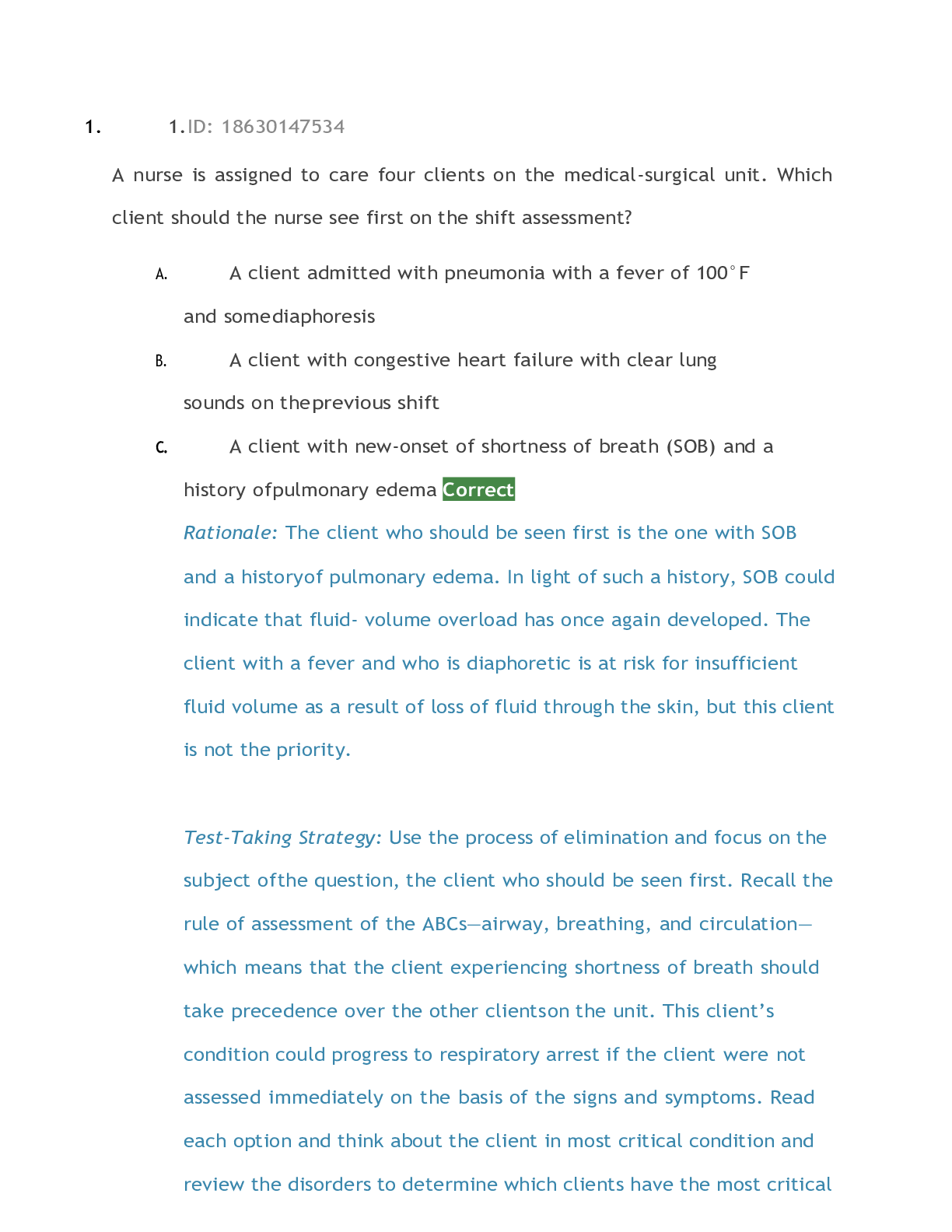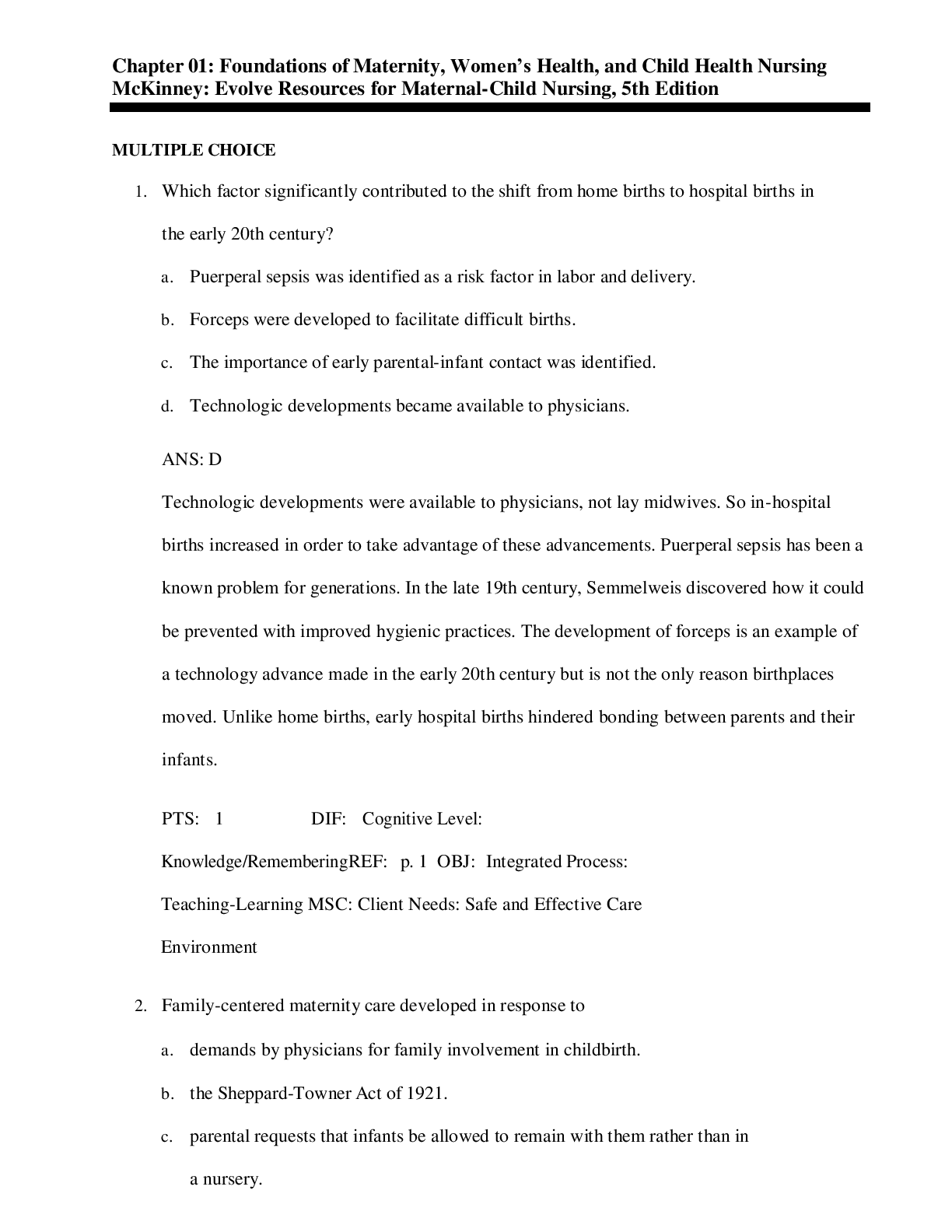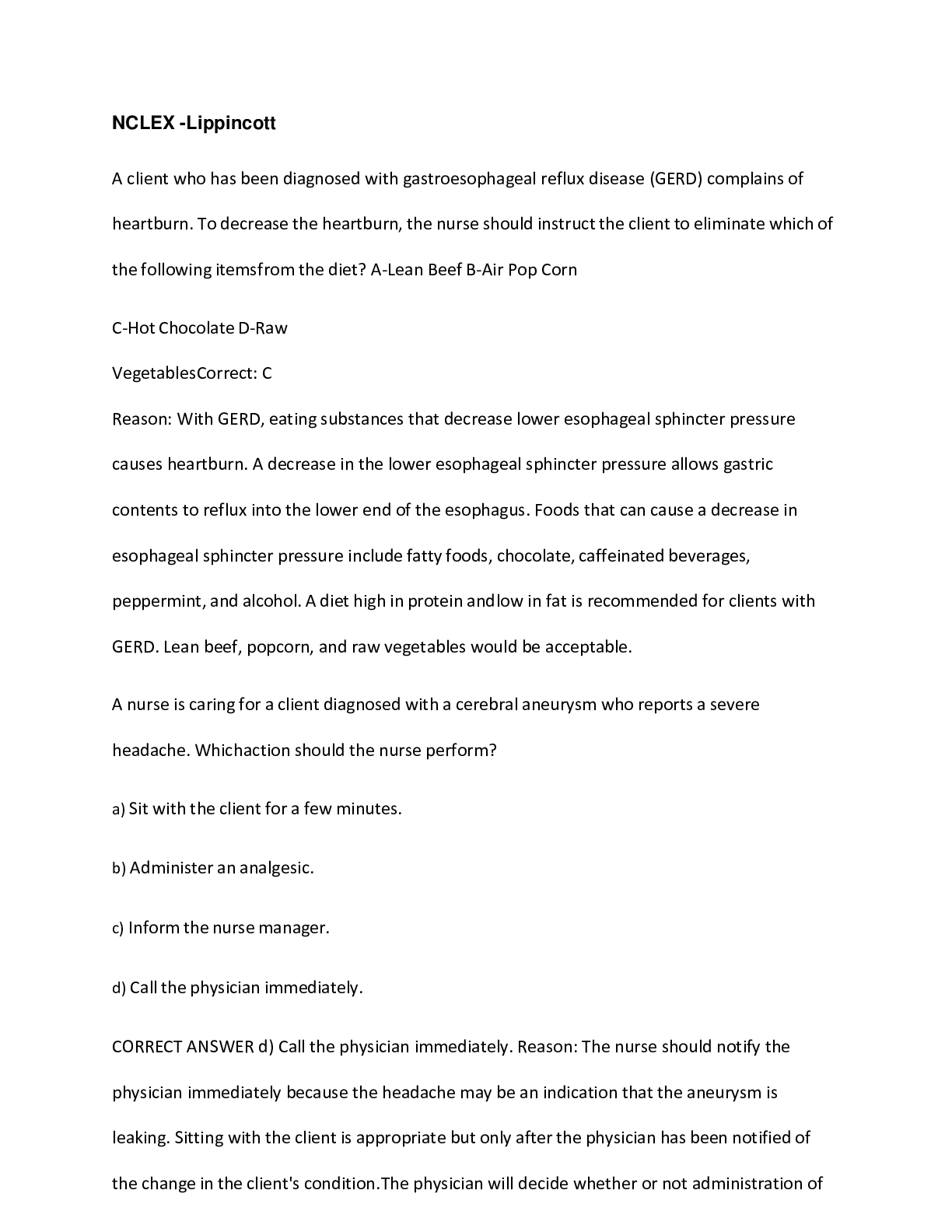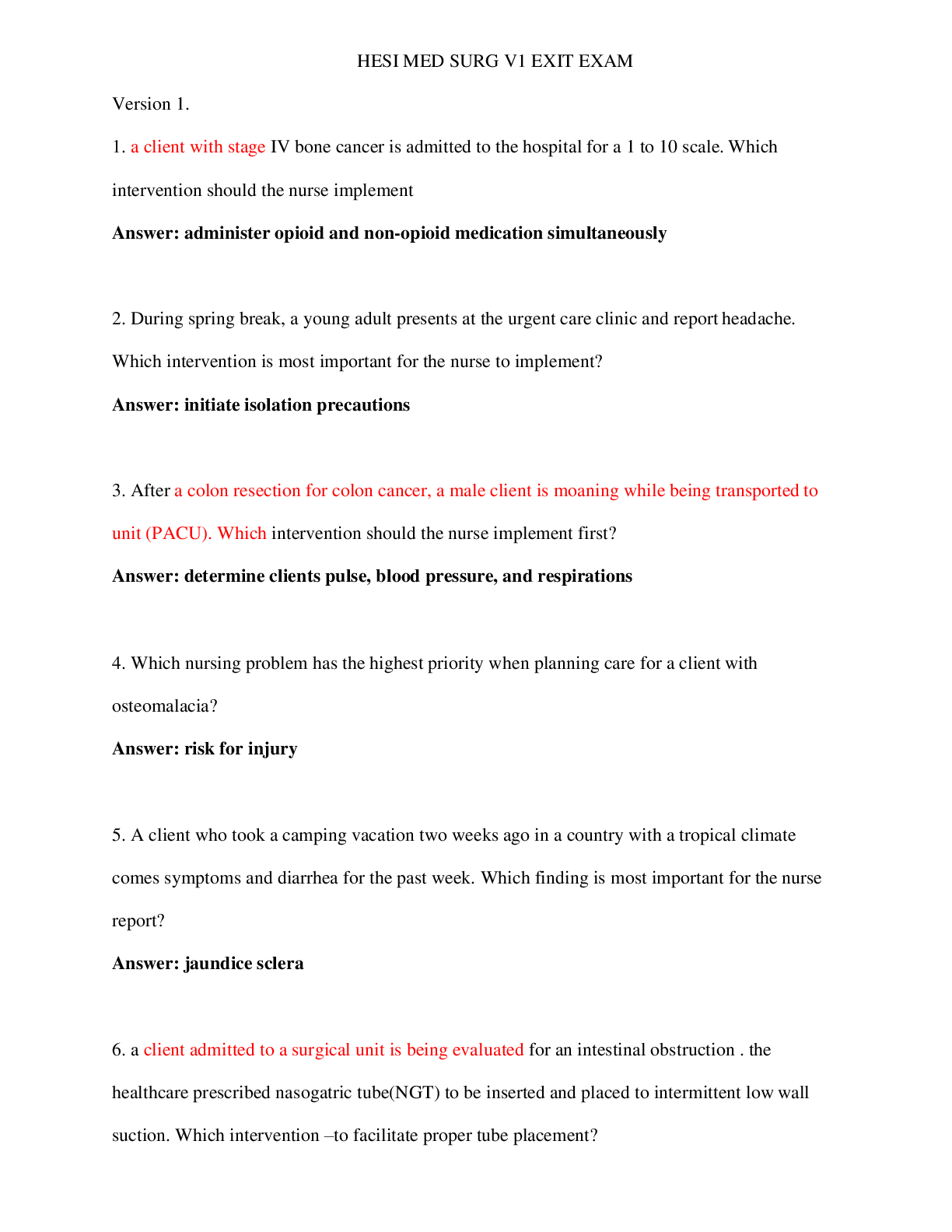*NURSING > QUESTIONS & ANSWERS > CPNRE PRACTICE EXAM - BOOK 1, All Questions with accurate answers, graded A+ (All)
CPNRE PRACTICE EXAM - BOOK 1, All Questions with accurate answers, graded A+
Document Content and Description Below
CPNRE PRACTICE EXAM - BOOK 1, All Questions with accurate answers, graded A+ Case Study: Nada Wasson delivered a healthy, 3600 g baby boy, Sandu, a week ago. She attends the newborn infant cli... nic at her local hospital, where the practical nurse examines Sandu. The practical nurse takes Sandu's vital signs. Which of the following would be normal for a 1-week-old infant? A- Heart rate 100 bpm, respirations 26 breaths per minute, blood pressure 44 mm Hg systolic B- Heart rate 165 bpm, respirations 65 breaths per minute, blood pressure 94 mm Hg systolic C- Heart rate 140 bpm, respirations 40 breaths per minute, blood pressure 70 mm Hg systolic D- Heart rate 130 bpm, respirations 32 breaths per minute, blood pressure 100 mg Hg systolic C- Heart rate 140 bpm, respirations 40 breaths per minute, blood pressure 70 mm Hg systolic Normal vital signs for a 1-week-old infant are heart rate 120-160 bpm, respirations 30-60 breaths per minute, and median blood pressure generally 65-80 mm Hg by Doppler (but can increase during crying or agitation) Case Study: Nada Wasson delivered a healthy, 3600 g baby boy, Sandu, a week ago. She attends the newborn infant clinic at her local hospital, where the practical nurse examines Sandu. The practical nurses tests Sandu's Babinski reflex. What is the expected response by Sandu to the Babinski test? A- Dorsiflexion of the big toe B- Flexion and extension of the leg C- Flexion of the fingers D- Extension and adduction of extremities A- Dorsiflexion of the big toe The Babinski reflex is elicited by stroking the outer sole of the foot upward from the heel across the ball of the foot, causing dorsiflexion of the big toe and fanning of the toes Case Study: Nada Wasson delivered a healthy, 3600 g baby boy, Sandu, a week ago. She attends the newborn infant clinic at her local hospital, where the practical nurse examines Sandu. The practical nurse obtains a weight of 3450 g for Sandu. Mrs. Wasson is concerned about the weight loss, telling the practical nurse that she is probably not producing enough milk. What would be the best response by the practical nurse? A- "This weight loss is normal in the first week. Continue breastfeeding at frequent intervals" B- "Although most newborns lose weight in the first week, you should probably supplement him with formula for the next few days" C- "This is not a significant weight loss, so don't be concerned" D- "To prevent further weight loss, you can increase your milk supply by drinking more liquids during the day" A- "This weight loss is normal in the first week. Continue breastfeeding at frequent intervals" This response best addresses Mrs. Wasson's concerns. A weight loss of up to 10% is expected 3-4 days after birth. Adequate breast milk supply is best facilitated by frequent feedings Case Study: Nada Wasson delivered a healthy, 3600 g baby boy, Sandu, a week ago. She attends the newborn infant clinic at her local hospital, where the practical nurse examines Sandu. Mrs. Wasson complains that her nipples are sore. What should the practical nurse suggest for care of the breasts? A- Air the nipples as much as possible B- Use a lanoiln-based cream after every feeding C- Use plastic-lined breast pads D- Begin nursing with the breast that is most painful A- Air the nipples as much as possible Airing the nipples as much as possible, and using heat will help dry the nipples and decrease discomfort Case Study: Nada Wasson delivered a healthy, 3600 g baby boy, Sandu, a week ago. She attends the newborn infant clinic at her local hospital, where the practical nurse examines Sandu. Mrs. Wasson plans to express breast milk for use when she has a babysitter. She asks the practical nurse how she should instruct the babysitter to warm the bottle. What should be the practical nurse's response? A- Place the bottle in a pot of water and heat slowly on top of the stove B- Place the bottle in a microwave oven and heat at low temperature C- Place the bottle in a bowl of lukewarm water D- Warming is not necessary, as the bottle can be used directly from the refrigerator C- Place the bottle in a bowl of lukewarm water Warming a bottle in lukewarm water is sufficient to bring it to room temperature Case Study: Edgar is a 14-year-old boy who was diagnosed with with type 1 diabetes at age 4 years. His blood sugar control has been poorly maintained for the past 2 months. It is suspected that the lack of control is related to an adolescent growth spurt and possible poor adherence to blood glucose monitoring, nutrition, and insulin administration. Edgar has been admitted to a short-stay unit in hospital for stabilization. When Edgar was diagnosed at age 4, he exhibited the cardinal symptoms for the three "polys". What are these manifestations? A- Polycythemia, polyuria, polymyositis B- Polydipsia, polyelectrolyte, polyneuropathy C- Polyopia, polyarthritis, polyphagia D- Polyphagia, polydipsia, polyuria D- Polyphagia, polydipsia, polyuria Polyphagia (excessive hunger and eating), polydipsia (excessive thirst), and polyuria (excessive urination) are cardinal manifestations of type 1 diabetes Case Study: Edgar is a 14-year-old boy who was diagnosed with with type 1 diabetes at age 4 years. His blood sugar control has been poorly maintained for the past 2 months. It is suspected that the lack of control is related to an adolescent growth spurt and possible poor adherence to blood glucose monitoring, nutrition, and insulin administration. Edgar has been admitted to a short-stay unit in hospital for stabilization. The practical nurse reviews insulin action, dosage, and administration with Edgar. What is the optimum insulin regimen for most children with diabetes? A- Twice daily injections for rapid-acting and intermediate-acting insulins B- Multiple daily injections of rapid and long-acting insulins C- Total dosage and percentage of regular to intermediate-acting insulins determined individually D- Ratio and dose determined by weight in kilograms C- Total dosage and percentage of regular to intermediate-acting insulins determined individually The precise dose of insulin and optimum regimen cannot be predicted and need to be individualized for every child. Insulin requirements do not remain constant, changing with growth, activity, and pubertal status Case Study: Edgar is a 14-year-old boy who was diagnosed with with type 1 diabetes at age 4 years. His blood sugar control has been poorly maintained for the past 2 months. It is suspected that the lack of control is related to an adolescent growth spurt and possible poor adherence to blood glucose monitoring, nutrition, and insulin administration. Edgar has been admitted to a short-stay unit in hospital for stabilization. Edgar admits to the practical nurse he has been experimenting with alcohol and binge drinking on the weekends. He states that his parents are "heavy drinkers" and are not aware of his behaviour. What is the most critical issue concerning Edgar's drinking of alcohol? A- Alcohol causes a rise in blood sugar, leading to a sustained period of hyperglycemia B- Binge drinking can lead to inappropriate and dangerous behaviours C- Alcohol causes a drop in blood sugar that could lead to severe hypoglycemia D- Because Edgar's parents are "heavy drinkers", he is more likely to develop a dependency on alcohol C- Alcohol causes a drop in blood sugar that could lead to severe hypoglycemia Alcohol causes hypoglycemia. The manifestations of slurred speech and antisocial combative behaviour are similar to those of being intoxicated; thus, Edgar may not receive appropriate life-saving treatment Case Study: Edgar is a 14-year-old boy who was diagnosed with with type 1 diabetes at age 4 years. His blood sugar control has been poorly maintained for the past 2 months. It is suspected that the lack of control is related to an adolescent growth spurt and possible poor adherence to blood glucose monitoring, nutrition, and insulin administration. Edgar has been admitted to a short-stay unit in hospital for stabilization. Edgar injects seven units of regular (Humulin R) insulin at 1600 hrs. When should the practical nurse caution him to be alert for a possible hypoglycemic episode? A- 1830 hrs B- 2030 hrs C- 2230 hrs D- 2400 hrs A- 1830 hrs The peak action for regular insulin is 2-4 hours after administration; therefore, a hypoglycemic episode may occur between 1800 and 2000 hours Case Study: Edgar is a 14-year-old boy who was diagnosed with with type 1 diabetes at age 4 years. His blood sugar control has been poorly maintained for the past 2 months. It is suspected that the lack of control is related to an adolescent growth spurt and possible poor adherence to blood glucose monitoring, nutrition, and insulin administration. Edgar has been admitted to a short-stay unit in hospital for stabilization. The practical nurse assesses the Edgar has been non-adherent to his diabetes management. What is the most appropriate nursing action to address Edgar's non-adherence? A- Ask Edgar's parents to supervise him more closely B- Provide education to Edgar and his family about the potential dangers of poorly controlled diabetes C- In private, explore Edgar's feelings about diabetes and the treatment regimen D- Suggest to Edgar that he join an adolescent diabetes support group C- In private, explore Edgar's feelings about diabetes and the treatment regimen Prior to implementing interventions, the practical nurse must be aware of the reasons for Edgar's nonadherence. The practical nurse should discuss this with him in private, as he may speak more freely when his parents are not present Case Study: A practical nurse works on a orthopaedic surgery unit of a hospital, Many of the clients are older adults with increased risk for hospital-acquired infections. Which of the following is the most important step for the practical nurse to protect her clients from hospital-acquired infections? A- Identify clients who are at risk B- Review hygiene practices with all clients C- Restrict visitors D- Lobby for the use of alcohol-based hand sanitizers A- Identify clients who are at risk Clients who are at high risk, for example, those who are immunosuppressed, need to be identified in order to implement appropriate precautions Case Study: A practical nurse works on a orthopaedic surgery unit of a hospital, Many of the clients are older adults with increased risk for hospital-acquired infections. Mr. Carolis, age 81, has just had a total hip replacement. He has a history of poor nutrition. Postoperatively, he has an in-dwelling urinary catheter. Which of these factors puts Mr. Carolis most at risk for developing an infection? A- Age B- Poor nutrition C- Surgery D- In-dwelling urinary catheter D- In-dwelling urinary catheter An in-dwelling catheter, even though it is a closed system, places Mr. Carolis at risk for a urinary tract infection and should be discontinued at the earliest opportunity Case Study: A practical nurse works on a orthopaedic surgery unit of a hospital, Many of the clients are older adults with increased risk for hospital-acquired infections. Mr. Carolis develops manifestations of an infection. Which of the following abnormal findings indicates that Mr. Carolis may have an infection? A- Leukocytosis B- Neutropenia C- Thrombocytosis D- Leukopenia A- Leukocytosis Leukocytosis is an abnormal increase in white blood cells and is indicative of an infection Case Study: A practical nurse works on a orthopaedic surgery unit of a hospital, Many of the clients are older adults with increased risk for hospital-acquired infections. Mr. Carolis is ordered to have urine cultures and then is started on intravenous antibiotics. What action should the practical nurse take with regard to the specimen collection and antibiotic administration? A- Commence the antibiotics as soon as the medication is received from the pharmacy department B- Ask the physician for the correct order for specimen collection and medication administration C- Take the urine sample from the in-dwelling catheter, and then commence the medication D- Administer the antibiotics, and then collect the urine sample from the urinary collection bag C- Take the urine sample from the in-dwelling catheter, and then commence the medication This is the correct sequence. Culture specimens can be inaccurate if taken after antibiotics are given Case Study: A practical nurse works on a orthopaedic surgery unit of a hospital, Many of the clients are older adults with increased risk for hospital-acquired infections. The practical nurse discovers that she has administered twice the ordered dose of a medication to Mr. Carolis. What is the most important initial action for the practical nurse to perform? A- Complete an incident report B- Notify the ordering physician C- Assess Mr. Carolis for adverse effects of the overdose D- Report the error to the nurse administrator C- Assess Mr. Carolis for adverse effects of the overdose The immediate action must be to address client safety. Administration of medication that is twice the ordered dose could have severe effects, particularly in an older client, and the nurse's first responsibility must be to assess Mr. Carolis Case Study: Mr. Kassam has chronic renal failure, secondary to type 2 diabetes. He has been attending an outpatient renal clinic for several years, and recently his condition has deteriorated. The practical nurse sees Mr. Kassam in the clinic. Which of the following laboratory blood test results would be the most concern to the practical nurse? A- Potassium: 7 mmol/L B- pH: 7.37 C- Sodium: 142 mmol/L D- Blood urea nitrogen (BUN): 6.8 mmol/L A- Potassium: 7 mmol/L Hyperkalemia, caused by decreased excretion by the kidney, is the most serious electrolyte disorder associated with kidney disease. A level of 7 mmol/L could result in a fatal arrhythmia Case Study: Mr. Kassam has chronic renal failure, secondary to type 2 diabetes. He has been attending an outpatient renal clinic for several years, and recently his condition has deteriorated. The practical nurse sees Mr. Kassam in the clinic. Mr. Kassam is on erythropoietin therapy. What is the rationale for this therapy? A- To treat the associated anemia B- To control hypertension C- To correct the acid-base balance D- To increase perfusion in the kidney A- To treat the associated anemia Administration of erythropoietin intravenously or subcutaneously is effective in treating the anemia that results from the decrease in erythropoietin production occurring with kidney failure Case Study: Mr. Kassam has chronic renal failure, secondary to type 2 diabetes. He has been attending an outpatient renal clinic for several years, and recently his condition has deteriorated. The practical nurse sees Mr. Kassam in the clinic. An important component of conservative treatment for chronic renal failure is diet therapy. Which of the following would be an appropriate lunch menu for Mr. Kassam? A- A 100 g cheese sandwich on whole wheat bread. a banana, and 200 mL of milk B- Canned tomato soup, 250 mL, saltine crackers, and a 400 mL of orange juice C- Turkey, 60 g on white bread with mayonnaise, an apple, and 250 mL of ginger ale D- Grilled beefsteak, 300 g, a baked potato, cooked spinach, and chocolate milk C- Turkey, 60 g on white bread with mayonnaise, an apple, and 250 mL of ginger ale Nutrition therapy in renal failure is complex. It requires the expert determination by a nutritionist of menus that comply with guidelines of low sodium, protein, and phosphorus; restricted fluids; and unlimited carbohydrates and fats to ensure sufficient calories. Turkey, mayonnaise, bread, an apple, and ginger ale comply with these guidelines Case Study: Mr. Kassam has chronic renal failure, secondary to type 2 diabetes. He has been attending an outpatient renal clinic for several years, and recently his condition has deteriorated. The practical nurse sees Mr. Kassam in the clinic. Following several months of dialysis, Mr. Kassam exclaims to the practical nurse, "I just can't do this anymore. I'd rather be dead!" What is the most therapeutic response by the practical nurse? A- "You'd rather be dead?" B- "This is very difficult treatment. Tell me what is bothering you the most" C- "Just hang on until we can get you a kidney transplant" D- "Are you depressed?" B- "This is very difficult treatment. Tell me what is bothering you the most" This is open-ended response confirms Mr. Kassam's feelings and invites him to share them Case Study: Mr. Kassam has chronic renal failure, secondary to type 2 diabetes. He has been attending an outpatient renal clinic for several years, and recently his condition has deteriorated. The practical nurse sees Mr. Kassam in the clinic. Mr. Kassam reveals to the practical nurse he has found an Internet site that provides kidney transplant surgery in another country for a significant amount of money. What is the practical nurse's professional responsibility in response to Mr. Kassam? A- Tell Mr. Kassam it is illegal to buy or sell organs in Canada B- Tell Mr. Kassam he must wait until he can receive a kidney in Canada C- Ask Mr. Kassam for more details about the Internet site and details of the transplant service D- Inform Mr. Kassam that he should not waste his money C- Ask Mr. Kassam for more details about the Internet site and details of the transplant service This response provides the practical nurse with more information about a potentially dangerous, illegal, or unethical situation. It allows for a respectful discussion between the practical nurse and Mr. Kassam Case Study: Mr. Kassam has chronic renal failure, secondary to type 2 diabetes. He has been attending an outpatient renal clinic for several years, and recently his condition has deteriorated. The practical nurse sees Mr. Kassam in the clinic. Mr. Kassam's condition is deteriorating, and he decides to no longer take dialysis. He tells the practical nurse he just wants to die. He is considering medical assistance in dying (MAID). Which of the following does not meet the criteria for MAID? A- The client is at least 18 years of age and capable of making decisions with respect to his or her health B- The client has a grievous and terminal medical condition C- The client has been encouraged by the physician and family members to request MAID to end his or her suffering D- The client gave informed consent to receive MAID after having been informed of the palliative care C- The client has been encouraged by the physician and family members to request MAID to end his or her suffering This is not criteria for MAID. Clients must voluntarily request MAID with no external pressure Case Study: Mrs. Dhillon, age 58, is suspected of having ovarian cancer. She has been referred by her family physician to an oncologist. The practical nurse consults with cancer clients in the physician's office. What are the early manifestations of ovarian cancer? A- Vague or mild symptoms of abdominal pressure and digestive problems. B- Painful menstrual periods with increased bleeding C- Sharp pain and swelling in the area of the affected ovary D- Swollen inguinal lymph nodes A- Vague or mild symptoms of abdominal pressure and digestive problems. Ovarian cancer in its early stages may not cause symptoms, or they may include mild pressure in the abdomen, pelvis, or back of the legs. There may be abdominal swelling or gastro-intestinal symptoms, such as indigestion, nausea, and bloating Case Study: Mrs. Dhillon, age 58, is suspected of having ovarian cancer. She has been referred by her family physician to an oncologist. The practical nurse consults with cancer clients in the physician's office. The oncologist plans a biopsy via laparoscopy. Mrs. Dhillon asks the practical nurse about this test. What should the practical nurse explain to Mrs. Dhillon? A- "A laparoscopy is the insertion of a large needle through the abdomen into the ovary to collect cells for biopsy" B- "A laparoscopy is an operation done through a surgical incision in the abdomen and be used to take a biopsy of ovarian tissue or remove any visible cancer" C- "A laparoscopy is the insertion of a flexible tube through a small cut in he abdomen, through which small biopsy samples can be taken" D- "A laparoscopy is the insertion of air into the fallopian tubes to enable ovarian cells to be withdrawn via the tubes" C- "A laparoscopy is the insertion of a flexible tube through a small cut in he abdomen, through which small biopsy samples can be taken" This is the correct definition of laparoscopy. It may be preferable to laparotomy as it is less invasive, is less painful, and only requires a local anaesthetic Case Study: Mrs. Dhillon, age 58, is suspected of having ovarian cancer. She has been referred by her family physician to an oncologist. The practical nurse consults with cancer clients in the physician's office. The results of the biopsy determine that Mrs. Dhillon has stage 3, grade 2 ovarian cancer. The practical nurse explains that these results help determine which treatment will be most effective for her. Which of the following is the correct interpretation of stage 3 grade 2? A- The cancer has spread to tissues in the pelvis but is slow-growing B- The cancer has spread to organs of the abdomen and lymph nodes but is spreading at moderate rate C- The cancer is confirmed to the ovaries but is highly likely to spread D- The cancer has spread outside the abdomen to distant parts of the body and is growing quickly B- The cancer has spread to organs of the abdomen and lymph nodes but is spreading at moderate rate This is the correct interpretation of grade 3, stage 2 Case Study: Mrs. Dhillon, age 58, is suspected of having ovarian cancer. She has been referred by her family physician to an oncologist. The practical nurse consults with cancer clients in the physician's office. The oncologist recommends surgery followed by chemotherapy to treat the cancer. Mrs. Dhillon telephones the practical nurse 2 days later, saying, "surgery is too drastic, and the chemotherapy is poison that will destroy my body". She will, instead, try some special herbs she has heard about from a friend. What is the best response by the practical nurse to Mrs. Dhillon? A- "These herbs have not likely been tested for safety or effectiveness, so it is not known whether they will harm you or be effective for your cancer" B- "This is not recommended and will probably cause you to die sooner" C- "At this stage, you are in denial, so call us back when you change your mind" D- "You are right about the toxins in the chemotherapy, so it is a good idea to try the herbs first" A- "These herbs have not likely been tested for safety or effectiveness, so it is not known whether they will harm you or be effective for your cancer" This is factual information that will assist Mrs. Dhillon to make an informed decision about her treatment Case Study: Mrs. Dhillon, age 58, is suspected of having ovarian cancer. She has been referred by her family physician to an oncologist. The practical nurse consults with cancer clients in the physician's office. Mrs. Dhillon is experiencing difficulty deciding on a course of treatment for her cancer. She says to the practical nurse "I am just so depressed. It doesn't matter what treatment I have; I'll die anyway". What is the most appropriate response by the practical nurse? A- "Why do you feel this way?" B- "Everyone diagnosed with cancer feels this way just after they receive their diagnosis" C- "Everything will be fine as soon as you start your treatment" D- "Let's talk about your prognosis and treatment options" D- "Let's talk about your prognosis and treatment options" This is an open-ended response that invites further discussion with Mrs. Dhillon about her cancer and her feelings about the situation Case Study: A practical nurse works at a fitness centre. She has been employed to perform health assessments, health counselling, and first aid as necessary. Reza Morhudi, age 32 years, has just run 10 km on a treadmill and asks the practical nurse to take his blood pressure. The practical nurse obtains a reading of 146/90 mm Hg in Mr. Morhudi's right arm. What is the appropriate nursing action in response to his BP reading? A- Tell Mr. Morhudi to rest for 20 minutes and reassess the BP B- Obtain a second BP reading in his left arm C- Ask Mr. Morhudi if he has any history of hypertension D- Tell Mr. Morhudi this is a normal reading for a man of his age and fitness level A- Tell Mr. Morhudi to rest for 20 minutes and reassess the BP Physical activity increases the cardiac output and thus increases the BP. 20-30 minutes of rest following exercise is indicated before a resting BP can be considered reliable Case Study: A practical nurse works at a fitness centre. She has been employed to perform health assessments, health counselling, and first aid as necessary. The practical nurse is called to see Valerya Dove, who is on the floor of the gym, crying and saying she has "twisted" her ankle. What interventions should the practical nurse perform while waiting for the doctor to assess Ms. Dove's ankle? A- Heat, pressure, range of motion (ROM), analgesics B- Rest, ice, compression, elevation C- Cool, compresses, partial weight-bearing, maintaining joint in flexion D- Immobilization of the joint, then sending Ms. Dove to the emergency department for an x-ray B- Rest, ice, compression, elevation This is RICE treatment. Movement should be limited, cold is applied to produce hypothermia, compression with an elastic bandage limits swelling, and the limb is elevated to impede edema formation Case Study: A practical nurse works at a fitness centre. She has been employed to perform health assessments, health counselling, and first aid as necessary. Mr. Lackraj introduces himself to the practical nurse as a new client to the fitness centre. He is 54, obese, and flushed and appears short of breath. What should be the practical nurse's initial assessment question? A- "What has been your past pattern of exercise?" B- "What if your personal goal for an exercise plan?" C- "Have you consulted your physician about an exercise plan?" D- "Are you anticipating exercise will help you lose weight?" C- "Have you consulted your physician about an exercise plan?" Mr. Lackraj appears to have risk factors for a cardiovascular disease. All clients should consult with their physician prior to initiating an exercise plan Case Study: A practical nurse works at a fitness centre. She has been employed to perform health assessments, health counselling, and first aid as necessary. The practical nurse is concerned about transmission of pathogens among the clients of the fitness centre, as many people use the equipment during the day. What would be the most effective action to reduce the potential of transmission of communicable diseases? A- Terminal cleaning of all equipment at the end of the day B- Screening all clients for symptoms prior to use of equipment C- Creating a poster board with information about communicable diseases D- Installation of alcohol gel dispensers for client hand hygiene between uses of equipment D- Installation of alcohol gel dispensers for client hand hygiene between uses of equipment Hand hygiene is the most effective action to reduce the transmission of infectious diseases Case Study: A practical nurse works at a fitness centre. She has been employed to perform health assessments, health counselling, and first aid as necessary. What additional advice might the practical nurse provide to her clients regarding "gym hygiene"? A- Place a towel on any surfaces you will be touching with bare skin B- Bring your own towel and launder it once every five visits C- Do not use the shower at the gym D- Dress in pants and long-sleeved clothing rather than shorts and sleeveless tops A- Place a towel on any surfaces you will be touching with bare skin Placing a towel on common surfaces will protect the skin from bacteria that may be on the bench. Do not use the underside of the towel after it has been placed on the bench Case Study: A practical nurse works at a fitness centre. She has been employed to perform health assessments, health counselling, and first aid as necessary. The practical nurse has noticed that one of her adolescent clients, Bart Matthews, has developed acne and reduced body fat, with increased muscle size and strength. She suspects that he is using anabolic steroids to improve his sports performance. What would be the most appropriate approach for the practical nurse to initiate a discussion about the possible use of steroids? A- "I've noticed that your muscle size has increased quite a bit and you have developed acne" B- "Are you aware of the dangers of taking anabolic steroids?" C- "Did you know that using anabolic steroids would disqualify you from sports competitions?" D- "Are you taking any supplements to improve your performance?" A- "I've noticed that your muscle size has increased quite a bit and you have developed acne" This initial answer is a statement of facts and does not accuse Mr. Matthews. It will likely lead to a discussion of the causes of his muscle bulk and acne Case Study: Raize Manche is a 59-year-old woman who has been admitted to an inpatient psychiatric unit following a suicide attempt. She appears unkempt, lethargic, and tearful. She tells her primary practical nurse, "I'm no use to anyone. There's no point in me going on". Her diagnosis is dysthymia with suicidal ideation. During an interaction, Ms. Manche tells the practical nurse that no one cares about her, but she does love her grandchildren. What would be the most therapeutic response by the practical nurse? A- "Tell me more about your grandchildren" B- "I am sure that your family does care about you" C- "If you talk about your feelings, you will feel better and enjoy your grandchildren more" D- "Your grandchildren would be very upset if you harmed yourself" A- "Tell me more about your grandchildren" The depressed client often has difficulty acknowledging any positive aspects of his or her life. By asking about the grandchildren that Ms. Manche loves, the practical nurse is reinforcing that she has worthwhile relationships Case Study: Raize Manche is a 59-year-old woman who has been admitted to an inpatient psychiatric unit following a suicide attempt. She appears unkempt, lethargic, and tearful. She tells her primary practical nurse, "I'm no use to anyone. There's no point in me going on". Her diagnosis is dysthymia with suicidal ideation. Ms. Manche has not been eating during her depression and tells the practical nurse she "just isn't hungry". What would be an appropriate intervention by the practical nurse to encourage adequate nutrition? A- Have Ms. Manche's family bring in food from home B- Consult with a dietician about the most appropriate menu for Ms. Manche's anorexia C- Offer Ms. Manche bland, high-protein foods D- Ask Ms. Manche what foods and drinks she likes to eat D- Ask Ms. Manche what foods and drinks she likes to eat Ms. Manche is more likely to eat foods that she prefers Case Study: Raize Manche is a 59-year-old woman who has been admitted to an inpatient psychiatric unit following a suicide attempt. She appears unkempt, lethargic, and tearful. She tells her primary practical nurse, "I'm no use to anyone. There's no point in me going on". Her diagnosis is dysthymia with suicidal ideation. After being on the unit for several days, Ms. Manche is asked to join a patient discussion group. Ms. Manche states that she does not want to go because she has "nothing to say". How would the practical nurse respond to Ms. Manche? A- "You must go to the group, but you don't have to talk" B- "Perhaps you could participate by talking about your grandchildren" C- "You feel you have nothing to say?" D- "The group will be very therapeutic for you" C- "You feel you have nothing to say?" This allows the practical nurse to further explore Ms. Manche's feelings of low self-worth and may lead to a discussion about the therapeutic effects of the group discuss [Show More]
Last updated: 1 year ago
Preview 1 out of 75 pages
Instant download

Buy this document to get the full access instantly
Instant Download Access after purchase
Add to cartInstant download
Also available in bundle (1)
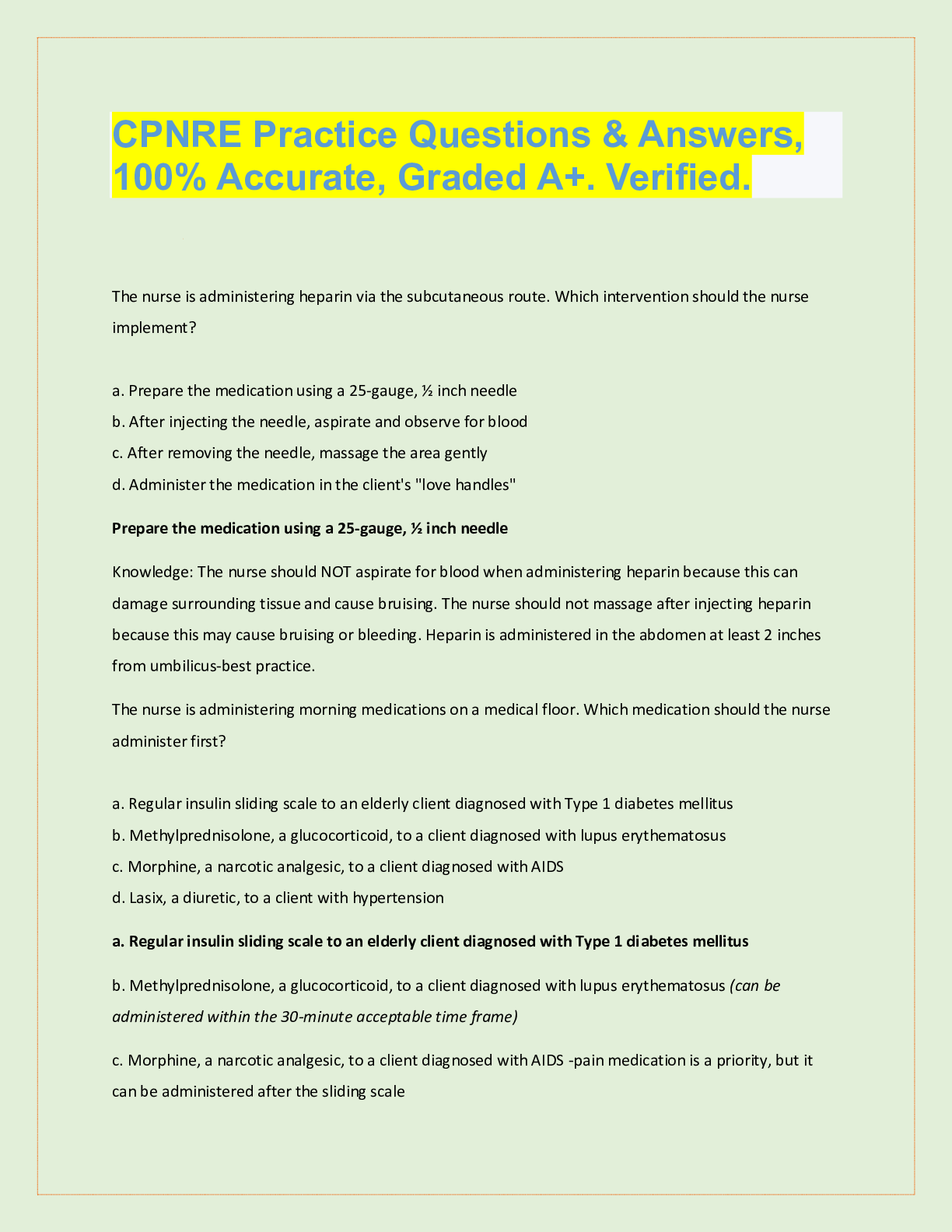
CPNRE Practice Exam Bundle, top Questions & Answers, graded A+
CPNRE Practice Questions & Answers, 100% Accurate, Graded A+. Verified. Exam predictor papers.
By Topmark 1 year ago
$34
8
Reviews( 0 )
Document information
Connected school, study & course
About the document
Uploaded On
Mar 14, 2023
Number of pages
75
Written in
Additional information
This document has been written for:
Uploaded
Mar 14, 2023
Downloads
0
Views
82






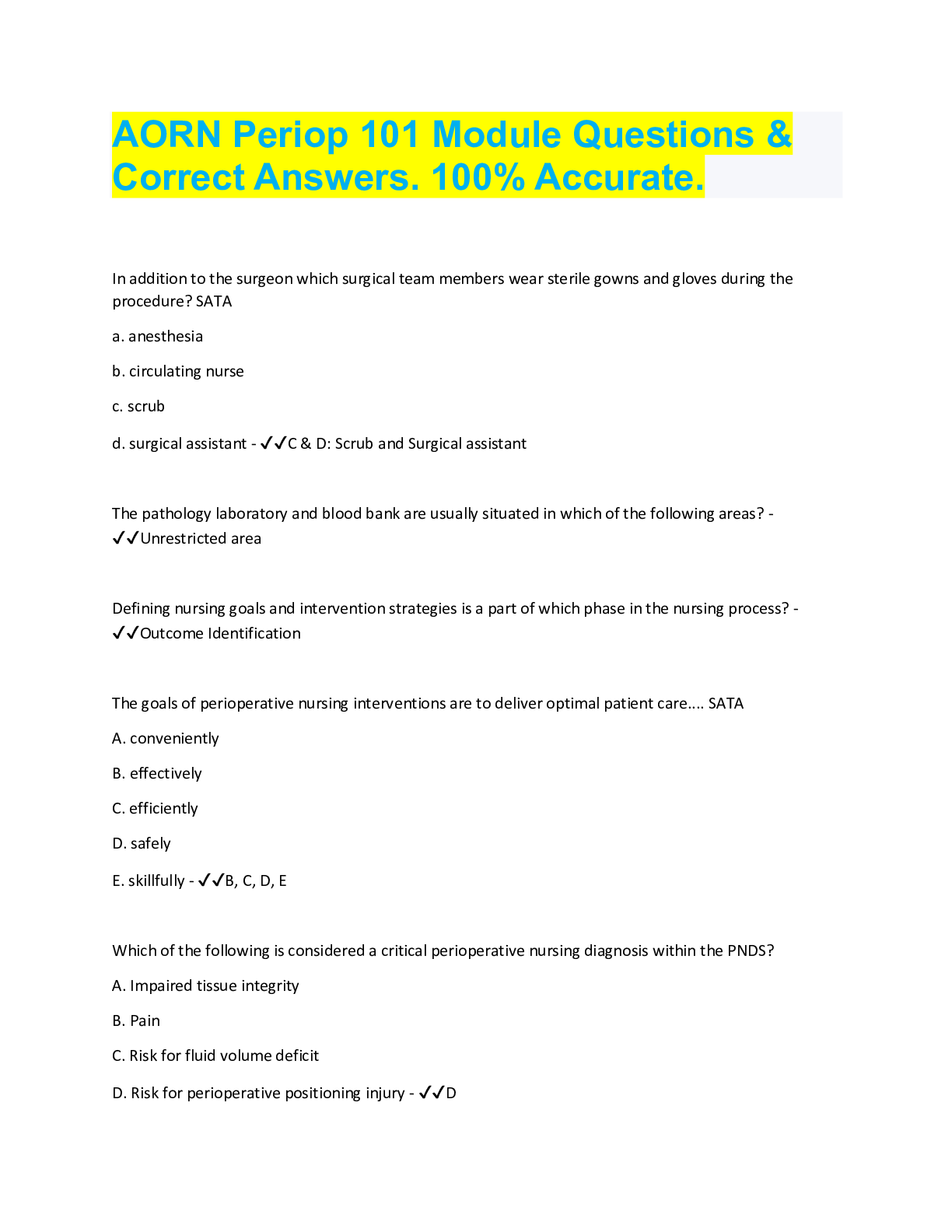





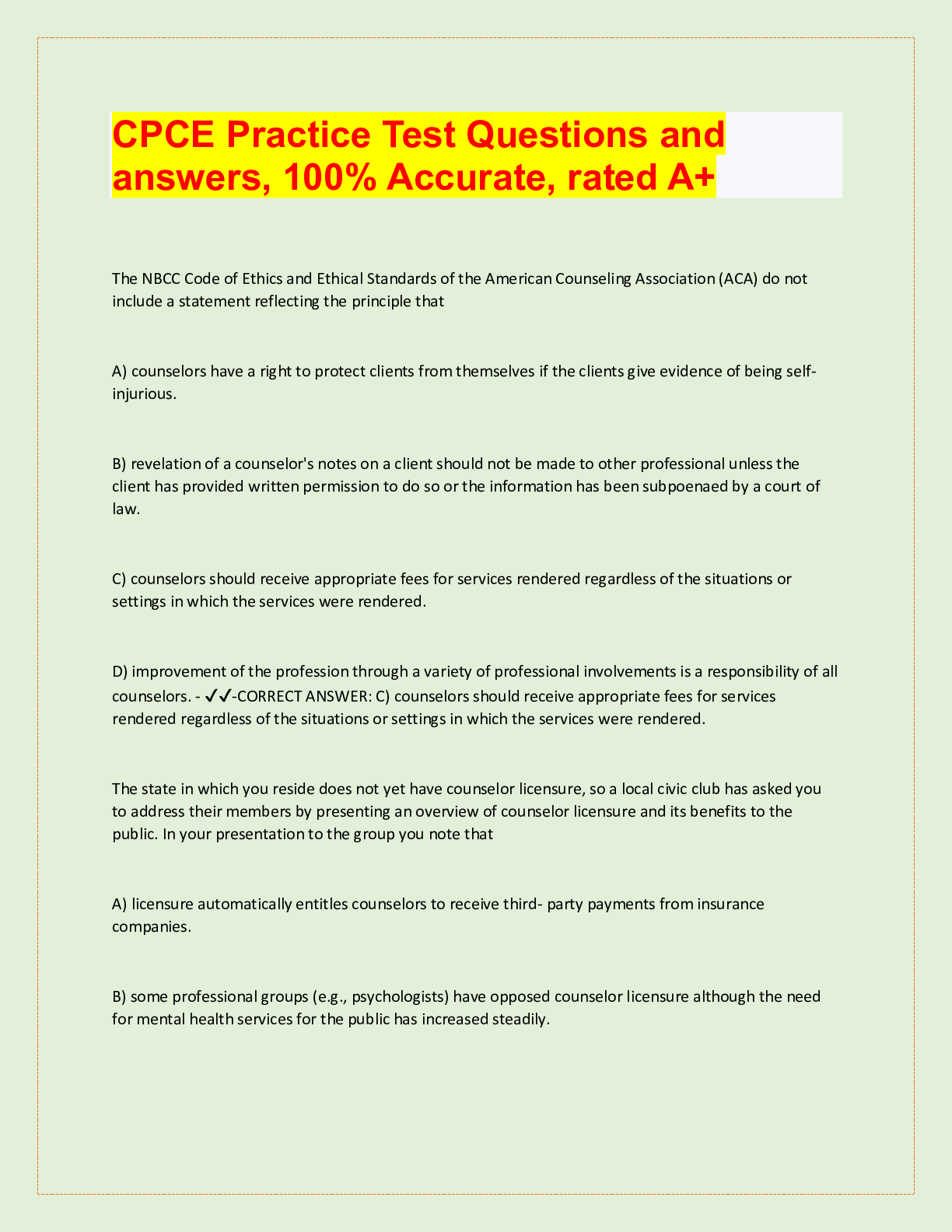



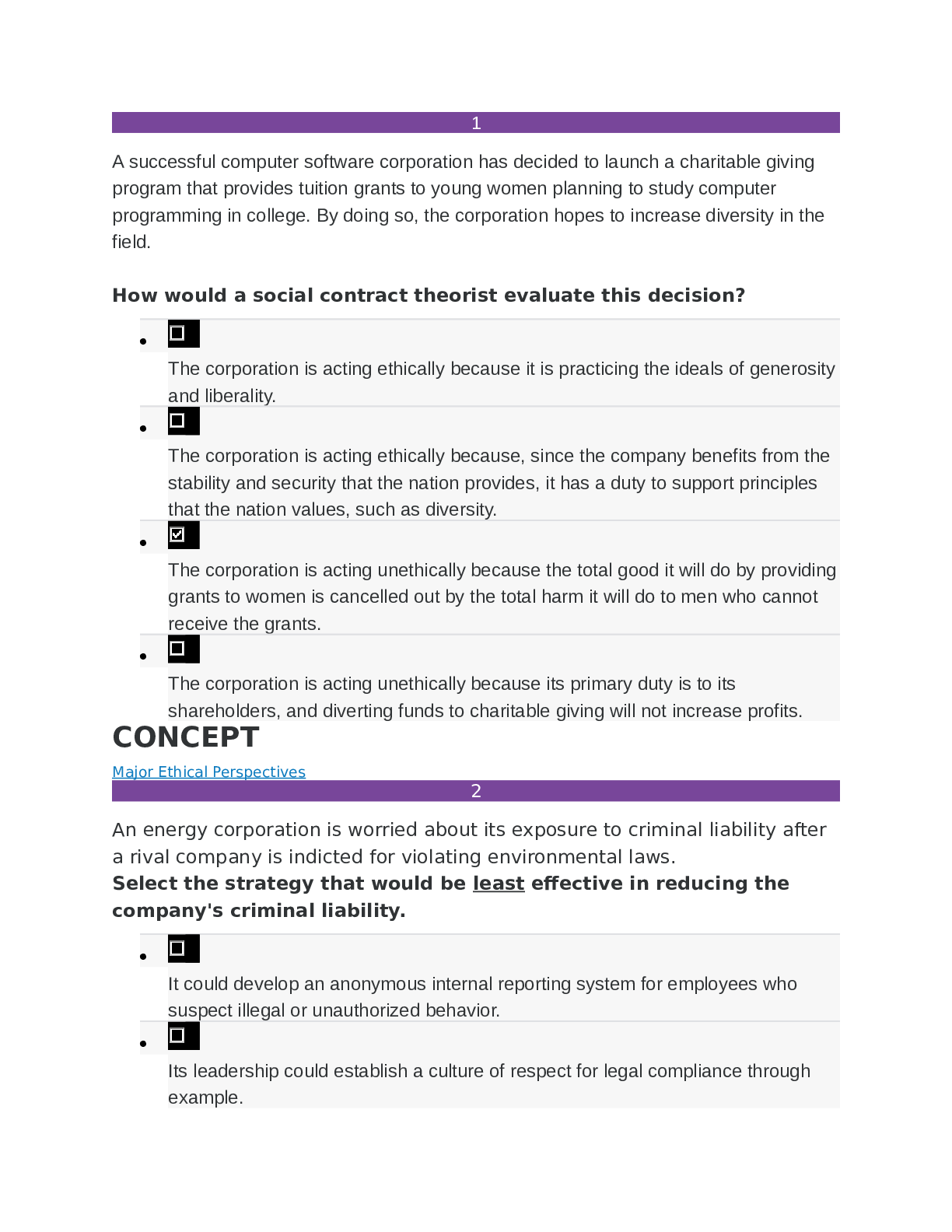
 Edition FINAL TEST BANK Spring 2021, All Chapters Quizzes Answers with Explanations.png)

 All Correct Study Guide, Download to Score A.png)
